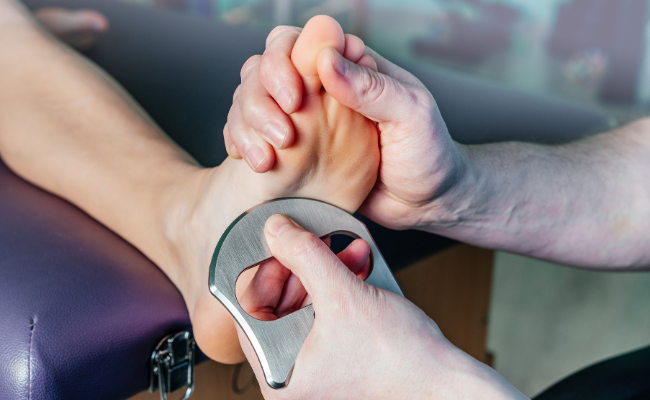How to Treat Soft Tissue Pain?
- November 10, 2023
- No Comments

What is Soft Tissue Pain?
Soft tissue pain refers to discomfort or soreness in the muscles, tendons, ligaments, or fascia—the connective tissues that support and surround organs and structures in the body. It is a common condition that can result from various causes, including injury, overuse, tension, or inflammation. Soft tissue pain can manifest as aching, stiffness, or a burning sensation, limiting mobility and impacting the overall quality of life for individuals experiencing it.
Why Does Soft Tissue Pain Occur?
Several factors contribute to the development of soft tissue pain. One primary cause is injury, which can range from sudden trauma, such as a strain or sprain, to chronic conditions like tendinitis or bursitis. Overuse of muscles, often seen in repetitive activities or improper body mechanics, can lead to strain and subsequent pain. Additionally, tension and stress can result in soft tissue pain, as the muscles tighten and become more susceptible to discomfort.
Inflammation is another common trigger for soft tissue pain. Conditions like arthritis or autoimmune disorders can cause the immune system to mistakenly attack healthy tissues, leading to inflammation and pain in the soft tissues. Understanding the underlying cause of soft tissue pain is crucial in determining the most effective treatment approach.
How to Treat Soft Tissue Pain?
- Rest and Ice: One of the initial steps in treating soft tissue pain is to allow the affected area to rest. Resting helps prevent further strain and promotes the natural healing process. Applying ice to the injured or painful area helps reduce inflammation and numbs the area, providing temporary relief. Ice packs or cold compresses should be applied for about 15-20 minutes every 2-3 hours during the initial stages of injury.
- Compression and Elevation: Compression, through the use of bandages or compression sleeves, helps reduce swelling and provides support to the injured area. Elevation, particularly for injuries in the extremities, helps minimize swelling by allowing fluids to drain away from the affected area. Combining compression and elevation can be particularly effective in managing soft tissue pain, especially after an acute injury.
- Pain Medications: Over-the-counter pain medications, such as nonsteroidal anti-inflammatory drugs (NSAIDs) like ibuprofen or acetaminophen, can be effective in managing soft tissue pain. These medications help reduce inflammation and alleviate pain. However, it's essential to use them as directed and consult with a healthcare professional, especially if there are concerns about potential side effects or interactions with other medications.
- Physical Therapy: Physical therapy is a valuable treatment option for soft tissue pain, particularly in cases of chronic or recurring issues. A physical therapist can design a tailored exercise program to strengthen muscles, improve flexibility, and enhance overall mobility. Therapeutic techniques may include stretching, strengthening exercises, and manual therapy to address specific soft tissue concerns.
- Heat Therapy: While ice is beneficial in the early stages of injury, heat therapy can be useful for chronic soft tissue pain or to relax tight muscles. Applying heat through hot packs, warm baths, or heating pads increases blood flow to the area, promoting healing and reducing muscle tension. It's crucial to use heat therapy cautiously and avoid excessive heat to prevent burns.
Treatment Solutions for Soft Tissue Pain:
- Massage Therapy: Massage therapy is an effective treatment solution for soft tissue pain. Skilled massage therapists can manipulate and knead the muscles, promoting relaxation, improving blood circulation, and reducing muscle tension. Different massage techniques, such as Swedish massage or deep tissue massage, may be employed based on the specific needs and preferences of the individual.
- Acupuncture: Acupuncture, an ancient Chinese practice, involves inserting thin needles into specific points on the body to promote healing and alleviate pain. While the exact mechanisms are not fully understood, acupuncture is believed to stimulate the release of endorphins, the body's natural painkillers, and modulate the nervous system. Many individuals find relief from soft tissue pain through acupuncture sessions.
- Topical Analgesics: Topical analgesic creams or patches containing ingredients like menthol, camphor, or NSAIDs can provide localized relief for soft tissue pain. These products are applied directly to the skin over the painful area and can help reduce inflammation and numb the region. They are convenient for targeted pain relief and may be used in conjunction with other treatment modalities.
Benefits of Various Soft Tissue Pain Treatments:
- Holistic Approach: Combining different treatment modalities allows for a holistic approach to managing soft tissue pain. Rest and ice address acute injuries, while physical therapy and exercises contribute to long-term rehabilitation. Integrating complementary therapies like massage or acupuncture enhances the overall effectiveness of the treatment plan, addressing both the symptoms and underlying causes of soft tissue pain.
- Customization for Individual Needs: The diverse range of treatment options for soft tissue pain allows for customization based on individual needs and preferences. What works for one person may not be as effective for another, and a personalized approach ensures that the chosen interventions align with the specific characteristics and causes of the soft tissue pain.
- Minimization of Medication Dependency: While pain medications can be beneficial, overreliance on them may lead to undesirable side effects or mask underlying issues. By incorporating non-pharmacological interventions such as physical therapy, massage, or acupuncture, individuals can minimize their dependence on medications and address soft tissue pain through diverse, sustainable means.
Comments (0)